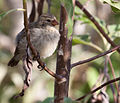Superregnum: Eukaryota
Regnum: Animalia
Subregnum: Eumetazoa
Cladus: Bilateria
Cladus: Nephrozoa
Superphylum: Deuterostomia
Phylum: Chordata
Cladus: Craniata
Subphylum: Vertebrata
Infraphylum: Gnathostomata
Superclassis: Tetrapoda
Cladus: Reptiliomorpha
Cladus: Amniota
Classis: Reptilia
Cladus: Eureptilia
Cladus: Romeriida
Subclassis: Diapsida
Cladus: Sauria
Infraclassis: Archosauromorpha
Cladus: Crurotarsi
Divisio: Archosauria
Subsectio: Ornithodira
Subtaxon: Dinosauromorpha
Cladus: Dinosauria
Ordo: Saurischia
Cladus: Theropoda
Cladus: Neotheropoda
Infraclassis: Aves
Ordo: Passeriformes
Subordo: Passeri
Infraordo: Passerida
Superfamilia: Passeroidea
Familia: Thraupidae
Genus: Camarhynchus
Species: C. heliobates – C. pallidus – C. parvulus – C. pauper – C. psittacula
Name
Camarhynchus Gould, 1837
Typus: Camarhynchus psittacula Gould, 1837
Synonyms
Cactospiza Ridgway, 1897 Proc.U.S.Nat.Mus. p. 546 BHL
References
Primary references
Gould, J. 1837. Remarks on a group of Ground Finches from Mr. Darwin's collection, with characters of New Species. Proceedings of the Zoological Society of London Pt 5 no.49: 4–7. BHL Reference page. Original description p. 6 BHL
Additional references
Lamichhaney, S., Berglund, J., Sällman Almén, M., Maqbool, K., Grabherr, M., Martinez-Barrio, A., Promerová, M., Rubin, C.J., Wang, C., Zamani, N., Grant, B.R., Grant, P.R., Webster, M.T. & Andersson, L. 2015. Evolution of Darwin’s finches and their beaks revealed by genome sequencing. Nature 518: 371–375. DOI: 10.1038/nature14181 Full article (PDF) Reference page.
Camarhynchus is a genus of birds in the tanager family Thraupidae. All species of Camarhynchus are endemic to the Galápagos Islands, and together with related genera, they are collectively known as Darwin's finches.[1] Formerly classified in the bunting and American sparrow family Emberizidae, more recent molecular genetic studies have shown it to belong in the tanager family.
Taxonomy and species list
The genus Camarhynchus was introduced in 1837 by English ornithologist John Gould, with the large tree finch as the type species.[2] The name combines the Ancient Greek kamara meaning "arch" or "vault" with rhunkhos meaning "bill".[3] The members of the genus form part of a group collectively known as Darwin's finches.[4] Although traditionally placed with the buntings and New World sparrows in the family Emberizidae,[5] molecular phylogenetic studies have shown that Darwin's finches are members of the subfamily Coerebinae within the tanager family Thraupidae.[6] The genus contains five species.[7]
| Image | Scientific name | Common name | Distribution |
|---|---|---|---|
 |
Camarhynchus parvulus | Small tree finch | Galapagos Islands. |
 |
Camarhynchus pauper | Medium tree finch | Galápagos Islands where it is only found on Floreana Island |
 |
Camarhynchus psittacula | Large tree finch | Galapagos Islands |
 |
Camarhynchus pallidus | Woodpecker finch | Galapagos Islands |
 |
Camarhynchus heliobates | Mangrove finch | Galápagos Islands |
The vegetarian finch (Platyspiza crassirostris) has sometimes been included in this genus.
References
White, Mel (11 May 2015). "A Darwin Finch, Crucial to Idea of Evolution, Fights for Survival". National Geographic. Retrieved 18 January 2016.
Gould, John (1837). "Remarks on a group of ground finches from Mr. Darwin's collection, with characters of new species". Proceedings of the Zoological Society of London. Part 5 (49): 4-7 [6].
Jobling, James A. (2010). The Helm Dictionary of Scientific Bird Names. London: Christopher Helm. p. 86. ISBN 978-1-4081-2501-4.
Sato, A.; Tichy, H.; O'hUigin, C.; Grant, P.R.; Grant, B.R.; Klein, J. (2001). "On the origin of Darwin's Finches". Molecular Biology and Evolution. 18 (3): 299–311. doi:10.1093/oxfordjournals.molbev.a003806.
Paynter, Raymond A. Jr, ed. (1970). Check-List of Birds of the World. Volume 13. Cambridge, Massachusetts: Museum of Comparative Zoology. p. 164.
Burns, K.J.; Shultz, A.J.; Title, P.O.; Mason, N.A.; Barker, F.K.; Klicka, J.; Lanyon, S.M.; Lovette, I.J. (2014). "Phylogenetics and diversification of tanagers (Passeriformes: Thraupidae), the largest radiation of Neotropical songbirds". Molecular Phylogenetics and Evolution. 75: 41–77. doi:10.1016/j.ympev.2014.02.006.
Gill, Frank; Donsker, David; Rasmussen, Pamela, eds. (July 2020). "Tanagers and allies". IOC World Bird List Version 10.2. International Ornithologists' Union. Retrieved 12 November 2020.
Retrieved from "http://en.wikipedia.org/"
All text is available under the terms of the GNU Free Documentation License

